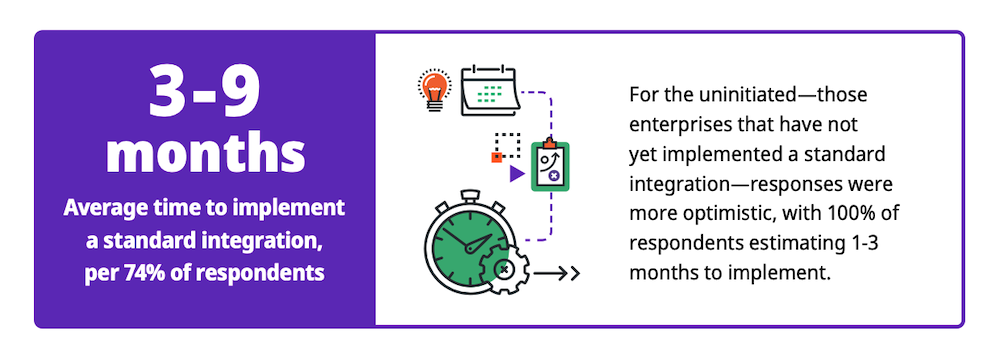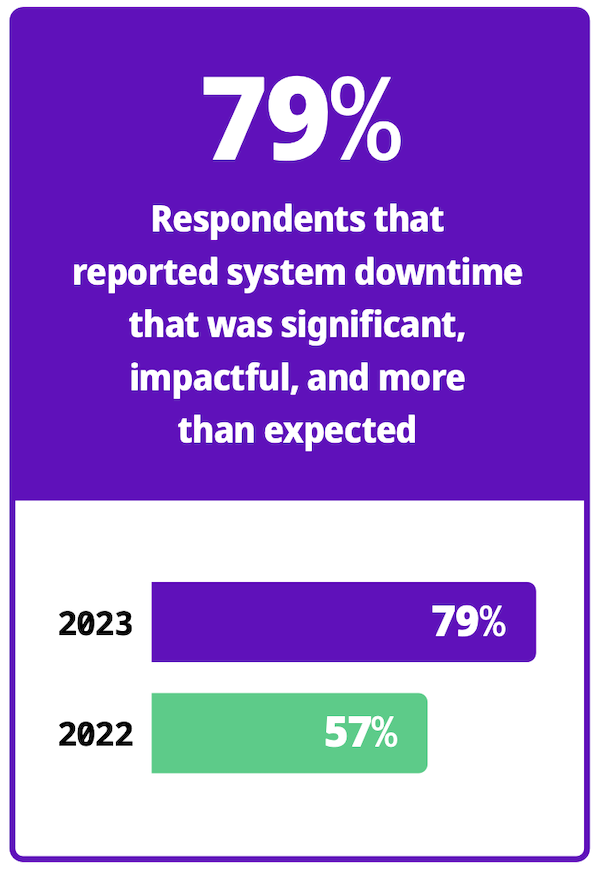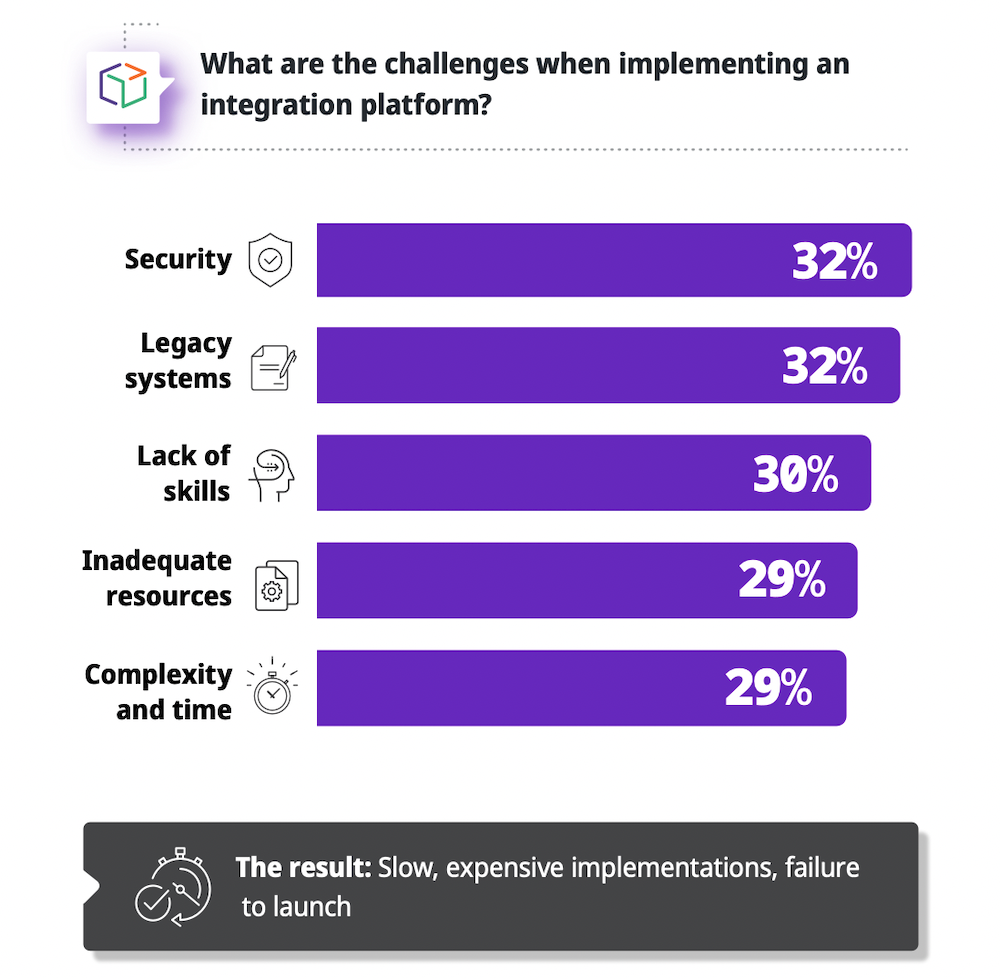maio 30, 2023
Em 2023, a Digibee’s realizou seu segundo evento anual Pesquisa de integração do estado da empresa, alcançando mil CTOs, CIOs, arquitetos de sistema e desenvolvedores da Web na América do Norte.
Nesta série de postagens de blog, examinamos uma das principais descobertas do relatório, classificada por seus colegas. O tempo de implementação se destacou como um dos maiores desafios ao embarcar em uma estratégia de transformação digital de TI. Muitos entrevistados disseram que, embora seu objetivo fosse acelerar a transformação digital, a implementação da integração levou muito mais tempo e foi mais complicada do que o esperado.
O Desafio: Tempo de Implementação da Integração
Os líderes empresariais de hoje entendem que a integração empresarial tornou-se um padrão do setor. Eles sabem que é necessário adotar tecnologias inovadoras que acelerem a transformação digital em toda a empresa para garantir o sucesso futuro. É por isso que a maioria dos entrevistados (71%) planeja ativamente adotar, complementar ou substituir sua tecnologia de integração em 2023 como parte de sua estratégia de transformação digital de TI.
À medida que os líderes de negócios começam a seguir seu plano de projeto de integração de sistemas sobre como acelerar a transformação digital, muitas organizações ficam atoladas durante o processo de implementação.
De acordo com o eBook da Digibee Relatório de integração do estado da empresa Digibee 2023, 100% dos entrevistados que ainda não começaram a implementar uma integração padrão estimaram que uma implementação levaria de um a três meses para ser concluída.
No entanto, 74% dos entrevistados que já iniciaram seu roteiro de estratégia de transformação digital descobriram que o tempo médio para implementar uma integração padrão é entre três e nove meses – até três vezes mais do que o esperado.
Quanto tempo sua equipe leva para implementar uma integração padrão?
Transformação digital e o custo do tempo de inatividade
O alto preço que pagamos pelos atrasos
Mesmo os melhores planos de transformação digital podem ser interrompidos por muitos fatores que levam a atrasos no tempo de implementação da integração. Atrasos podem ser causados por sistemas legados complexos, limitações de processos internos, pendências de TI, recursos inadequados e outros fatores inesperados, mas o relatório Digibee afirma que o maior impedimento para uma implementação mais rápida é tempo de inatividade do sistema.
Muitas vezes, o tempo de inatividade ocorre durante a implementação da integração, quando as organizações atualmente dependem de tecnologia desatualizada, sejam elas locais, sistemas internos complexos ou sistemas legados. As organizações com os ambientes mais desafiadores para converter geralmente enfrentam os atrasos de integração mais longos.
 Atrasar um plano de projeto de migração de software pode ter resultados caros. Atrasos inesperados, como tempo de inatividade, podem levar rapidamente a interrupções caras com efeitos generalizados que reduzem a aceleração da transformação digital.
Atrasar um plano de projeto de migração de software pode ter resultados caros. Atrasos inesperados, como tempo de inatividade, podem levar rapidamente a interrupções caras com efeitos generalizados que reduzem a aceleração da transformação digital.
O relatório da Information Technology Intelligence Consulting, The Hourly Cost of Downtime, afirma que “O custo do tempo de inatividade aumentou significativamente para 90% das PME e grandes empresas, com 44% relatando que uma única hora de inatividade poderia custar mais de US$ 1 milhão”.
In Relatório de 2023 da Digibee, a maioria (79%) dos entrevistados disse que o tempo de inatividade do sistema durante a integração teve um impacto significativo em seus negócios e foi uma interrupção muito maior do que o esperado. O número de entrevistados que tiveram tempo de inatividade inesperado foi significativamente maior do que o relatório do ano passado, que foi de 57%.
Embora mais de três quartos dos entrevistados tenham lidado com tempo de inatividade não planejado ao implementar seu plano de projeto de integração de sistema, o tempo de inatividade não é o único fator que impede os planos de projeto de migração de software, e o custo nem sempre é o fator mais importante. Na verdade, embora o orçamento tenha encabeçado a lista de desafios de integração no relatório Digibee do ano passado, não estava nem entre os cinco principais desafios para 2023.
Outros desafios enfrentados pelos líderes de negócios este ano incluem problemas de segurança, sistemas legados, falta de habilidades e recursos inadequados nas organizações, bem como a crescente complexidade e o tempo necessário para implementar e manter integrações de sistemas. Isso geralmente resulta em investimentos adicionais em manutenção e treinamento. Todos esses problemas podem levar a implementações mais lentas e caras que podem reduzir o retorno sobre o investimento (ROI), o que acaba afetando o ROI geral da transformação digital.

Com tantos desafios a serem superados, não é surpresa que mais de 70% dos líderes entrevistados estejam planejando ativamente adotar, complementar ou substituir sua tecnologia de integração em 2023.
Superando desafios de tempo de implementação com iPaaS
No papel, um plano de transformação digital pode parecer simples, mas, na realidade, todas as variáveis envolvidas em um plano típico de projeto de migração podem tornar o tempo de implementação muito mais longo e complicado do que o esperado. Integrações ineficazes impedem a lucratividade, portanto, os líderes de negócios devem ter uma sólida estratégia de transformação digital de TI e um plano de projeto de integração de sistemas para o processo de implementação.
A maneira mais eficaz de garantir a aceleração bem-sucedida da transformação digital é aproveitar a tecnologia moderna com um ambiente de plataforma como serviço (iPaaS) de integração empresarial. Um iPaaS com interfaces de arrastar e soltar pode tornar a implementação de um plano de projeto de integração de software mais rápida e fácil.
Digibee fornece uma experiência de integração de TI rápida e simplificada. O iPaaS fácil de usar da Digibee é uma plataforma de integração nativa da nuvem e pronta para empresas que acelera o tempo de valorização, reduz os riscos e ajuda a reduzir os custos de TI. Por exemplo, a Digibee integrou uma plataforma segura de e-commerce iPaaS para varejista global de calçados Payless Shoes em mais de 400 lojas em 15 países em menos de 30 dias. Como é isso para rápido e fácil? O sistema iPaaS lida facilmente com picos sazonais para o varejista ocupado e oferece melhor eficiência, transparência e segurança em toda a empresa de varejo, apesar de cada país ter diferentes requisitos fiscais e legais.
A aceleração da transformação digital pode ser feita com rapidez e sucesso, desde que você adote a abordagem correta com um roteiro de estratégia de transformação digital eficaz com suporte da tecnologia iPaaS.
Obtenha a história completa sobre o que mudou e como seus colegas estão mobilizando a integração empresarial em 2023. Faça o download gratuito do relatório de integração do estado da empresa Digibee 2023 hoje para todos os resultados da pesquisa e a análise.









